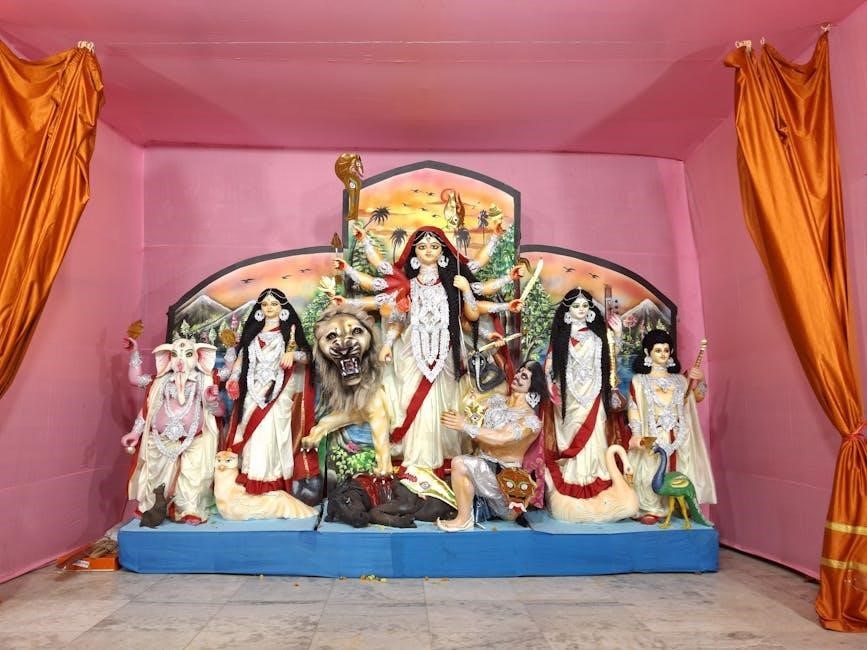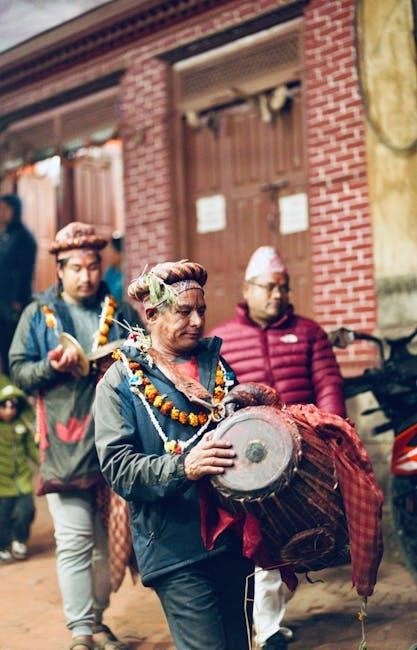Mahishasura Mardini, a powerful deity in Hindu mythology, embodies the divine feminine and triumph over evil․ Her legendary battle with Mahishasura symbolizes good’s victory over darkness, inspiring devotion and spiritual growth through the revered Mahishasura Mardini Stotram․
The Legend of Mahishasura Mardini
The legend of Mahishasura Mardini revolves around Goddess Durga’s triumph over the buffalo-demon Mahishasura․ This epic battle, detailed in Hindu scriptures, symbolizes the eternal conflict between good and evil․ Mahishasura, once granted invincibility by Lord Brahma, terrorized the universe until the gods united to create Durga․ Armed with divine weapons, she slayed the demon, restoring cosmic balance․ This legendary victory is celebrated in the Mahishasura Mardini Stotram, a hymn that glorifies Durga’s power and divine grace․
Significance of Mahishasura Mardini in Hindu Mythology
Mahishasura Mardini holds profound significance as a symbol of divine feminine power and the triumph of good over evil․ She embodies Goddess Durga’s role as a protector of the universe, showcasing her divine attributes of courage, wisdom, and strength․ The legend underscores the cosmic balance restored by her victory, inspiring devotees to seek her blessings for protection and empowerment․ Her worship is deeply rooted in Hindu culture, emphasizing the divine feminine’s role in maintaining harmony and justice․
Historical Background
Mahishasura Mardini’s origins are rooted in ancient Hindu scriptures, with her legendary battle and divine attributes evolving over centuries through various texts and cultural influences․
Origins of the Mahishasura Mardini Story
The story of Mahishasura Mardini originates from ancient Hindu scriptures, including the Vedas and Puranas․ The Devi Mahatmyam narrates her divine emergence to slay Mahishasura, a buffalo-demon, symbolizing the triumph of good over evil․ Historical evidence, such as sculptures in temples like the Parasurameswar temple in Bhubaneswar, dates back to the 6th/7th Century A․D․, showcasing her enduring cultural significance․ The hymn is attributed to Guru Adi Shankaracharya, with regional influences enriching the legend over time․
Evolution of the Legend Over Time
The legend of Mahishasura Mardini has evolved over centuries, influenced by regional cultures and traditions․ The story, rooted in Hindu scriptures like the Devi Mahatmyam, has been enriched by artistic depictions in temple sculptures and literary works․ Over time, the hymn Mahishasura Mardini Stotram, attributed to Guru Adi Shankaracharya, gained prominence, becoming a revered devotional text․ Its availability in PDF formats has further popularized it, ensuring its reach to a modern audience while preserving its spiritual essence․
Cultural Significance
Mahishasura Mardini embodies empowerment and spirituality, inspiring art, festivals, and literature․ Her story, celebrated in PDF formats, reflects cultural identity and divine femininity, resonating deeply across generations․
The Role of Mahishasura Mardini in Indian Culture
Mahishasura Mardini is a cultural icon, symbolizing divine feminine power and the triumph of good over evil; Her legend inspires art, literature, and festivals, reinforcing spiritual values․ As a protector and savior, she is deeply revered, embodying courage and wisdom․ Her story, widely available in PDF formats, is central to Navratri and Dussehra celebrations, fostering unity and devotion across India․ Her cultural significance transcends religion, resonating as a universal symbol of strength and resilience․
Celebration of Mahishasura Mardini During Navratri
During Navratri, Mahishasura Mardini is celebrated as a symbol of divine feminine power and the victory of good over evil․ The nine-day festival honors her nine divine forms, with devotees chanting the Mahishasura Mardini Stotram for spiritual enlightenment․ Rituals, dances, and cultural performances highlight her triumph, fostering devotion and unity․ PDF versions of the stotram and related stories are widely shared, enabling worshippers to connect deeply with the deity’s divine essence during this sacred period․
PDF Resources
Mahishasura Mardini PDF resources are widely available online, offering chants, stories, and spiritual significance․ Advanced search features help users easily find these files, enhancing their worship experience․
Availability of Mahishasura Mardini PDF Online
Mahishasura Mardini PDFs are readily available online, offering easy access to chants, stories, and spiritual guides․ Users can search on platforms like Google, specific religious websites, or e-book repositories․ By filtering search results to include only PDF files, devotees and researchers can quickly locate and download these resources․ The documents often include lyrics, translations, and detailed explanations, making them invaluable for worship and study․
How to Download Mahishasura Mardini Stotram PDF
To download the Mahishasura Mardini Stotram PDF, users can search on platforms like Google or religious websites․ Use keywords such as “Mahishasura Mardini Stotram PDF” or “Mahishasura Mardini lyrics in PDF․” Filter search results by file type to find PDFs quickly․ Visit trusted sites or temples offering free downloads․ Some resources may require a small contribution to access․ Ensure the source is reliable for accurate and authentic content․

Importance of the Stotram
Mahishasura Mardini Stotram is a sacred hymn embodying divine energy and strength․ It is chanted for spiritual growth, protection, and empowerment, resonating deeply with devotees seeking solace and courage․
Spiritual Significance of the Mahishasura Mardini Stotram
The Mahishasura Mardini Stotram holds profound spiritual significance, embodying the divine energy of Goddess Durga․ It narrates her triumphant battle over Mahishasura, symbolizing the victory of good over evil․ Devotees chant this hymn to invoke courage, strength, and protection, believing it purifies the soul and grants spiritual enlightenment․ Its verses resonate with devotion, fostering a deep connection to the divine feminine and inspiring seekers on their spiritual journey toward inner peace and self-realization․
Emotional and Psychological Benefits of Chanting the Stotram
Chanting the Mahishasura Mardini Stotram offers profound emotional and psychological benefits․ It fosters inner peace, reduces stress, and enhances mental clarity․ The rhythmic recitation helps devotees connect with divine energy, promoting emotional balance and resilience․ By invoking Goddess Durga’s strength, it empowers individuals to overcome fear and anxiety, cultivating confidence and positivity․ Regular chanting also aids in spiritual well-being, helping practitioners navigate life’s challenges with grace and inner strength, ultimately leading to a harmonious mind and heart;

Worshipping Guidelines
Worship Mahishasura Mardini with purity of heart and mind․ Offer flowers, incense, and recite the stotram with concentration for divine blessings and spiritual harmony․
Do’s and Don’ts While Worshiping Mahishasura Mardini
While worshiping Mahishasura Mardini, maintain purity of mind and body․ Offer flowers, incense, and recite the stotram with devotion․ Seek guidance from a guru for proper rituals․ Avoid non-vegetarian offerings and distractions during worship․ Ensure the worship space is clean and sacred․ Chant the stotram with focus and sincerity for maximum spiritual benefit․ Avoid worshiping without proper preparation or intention․ Follow traditional practices to honor the goddess respectfully․

Symbols and Iconography
Mahishasura Mardini is depicted with multiple arms, riding a lion, and wielding a trident and discus, symbolizing supreme divine power and victory over evil forces․
Understanding the Iconography of Mahishasura Mardini
Mahishasura Mardini’s iconography depicts her as a fierce warrior with multiple arms, riding a lion, symbolizing courage and divine power․ She wields weapons like the trident and discus, embodying her role as a protector and destroyer of evil․ Her image often shows her slaying the buffalo-demon Mahishasura, representing the triumph of good over darkness․ The lion, her mount, signifies unwavering strength, while her serene expression reflects divine grace and compassion․
The Weapons and Symbols Associated with the Goddess
Mahishasura Mardini is often depicted wielding powerful weapons such as the trident, discus, and sword, symbolizing her divine authority and strength․ The trident represents her power to destroy evil, while the discus embodies cosmic order․ Her mount, the lion, signifies fearless courage and divine energy․ These symbols collectively portray her as a protector and warrior, embodying the triumph of good over darkness․ Each weapon and symbol reinforces her role as a fierce yet benevolent deity․
Festivals and Rituals
Festivals like Navratri and Dussehra celebrate Mahishasura Mardini’s victory, honoring her divine power through rituals, chants, and devotional practices that embody the triumph of good over evil․
The Role of Mahishasura Mardini in Navratri Celebrations
Navratri, a nine-day festival, honors Mahishasura Mardini as a symbol of divine feminine power․ Her victory over Mahishasura is central to the celebrations, inspiring rituals, chants, and recitals of the Stotram․ Devotees worship her through elaborate puja and cultural performances, celebrating her triumph over evil․ The festival embodies the themes of purity, strength, and wisdom, resonating deeply with spiritual and cultural traditions․ Mahishasura Mardini’s essence is invoked to seek blessings and inner strength during this sacred period․
Special Rituals During Dussehra
Dussehra commemorates the victory of good over evil, with Mahishasura Mardini embodying this triumph․ Rituals include processions, puja, and recitals of the Stotram․ Effigies of demons are burned symbolizing destruction of evil․ Devotees perform Shami Puja, offering prayers and sweets to Goddess Durga․ These rituals foster unity, faith, and cultural heritage, celebrating divine power and the eternal victory of righteousness over darkness․

Available PDF Versions
Mahishasura Mardini Stotram PDFs are widely available, offering translations, chants, and commentary․ These resources provide spiritual insights, making the divine hymn accessible for devotion and study․
Popular PDF Versions of Mahishasura Mardini Stotram
Several popular PDF versions of the Mahishasura Mardini Stotram are available, offering diverse formats and translations․ These include the original Sanskrit text, translated versions in multiple languages, and transliterated editions for easy chanting․ Many PDFs feature commentary and explanations, enhancing spiritual understanding․ Popular versions like the Aigiri Nandini hymn and regional variations are widely downloaded․ These resources cater to devotees seeking deeper connection and scholars exploring the stotram’s significance, making them accessible for both spiritual and academic purposes․
Guides and Translations Available in PDF Format
Guides and translations of the Mahishasura Mardini Stotram are widely available in PDF format, catering to diverse spiritual and academic needs․ These resources include detailed commentary, word-by-word meanings, and explanations of the hymn’s significance․ Translations in English, Hindi, and other regional languages make the stotram accessible to global devotees․ Additionally, guides often provide chanting tips, rituals, and historical context, enriching the understanding of this sacred text․ These PDFs serve as invaluable tools for both spiritual practitioners and scholars exploring Hindu mythology․



